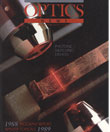
February, 1989 Issue
Feature Articles
Computational machines and optical coatings in the 1950s and later
Most Optics News' readers are familiar with optical coatings. They are applied to the lenses of SLR cameras as antireflection coatings, on the mirrors used in lasers, and on the architectural glass of buildings. Most of these coatings were designed on digital computers. This article recalls some of the tribulations of computing the spectral transmittance of such coatings in the 1950s, focusing on some of the early work in that field. Nearly all who somehow survived that era will readily agree that "the good ol' days" were not all that good.
by Philip BaumeisterStandards in Works for Computer Talk on Optical Design
At the recent Monterey meeting of ISO/TC 172/SC 1, it was decided to undertake a new task—the definition of a data file for the transmission of optical design data between various computers and computer programs. This work will be done by a task group within SC 1 under the direction of Eckart Wieder of Carl Zeiss, Oberkochen, FRG.
by Robert E. ParksPhotonic switching devices
Light signals travel in optical fibers over hundreds of kilometers and are still detected. This extraordinary transmission phenomena turned optical communications into a successful technology in a very short time. Why is light so good for transmission? The fundamental reason has to do with the fact that light is not perturbed easily: a photon is a very inert particle. It is not easy to deflect a photon from its course. Unlike electrons it will not be affected by charges or by the presence of other photons. Only the interaction of light with matter can affect its propagation. By a proper choice and careful preparation, very transparent materials can be made. Moreover, photons are relatively easy to generate and detect using absorbing transitions. (Neutrinos could propagate with even less loss, but alas, they are very difficult to create and detect!)
by Yaron Silberberg

![A multiplexed image of a human tonsil acquired. [NIAID] using the iterative bleaching extends multiplexity (IBEX) method.](https://opnmedia.blob.core.windows.net/$web/opn/media/images/articles/2024/0424/departments/202404-cover-web.jpg?ext=.jpg)
